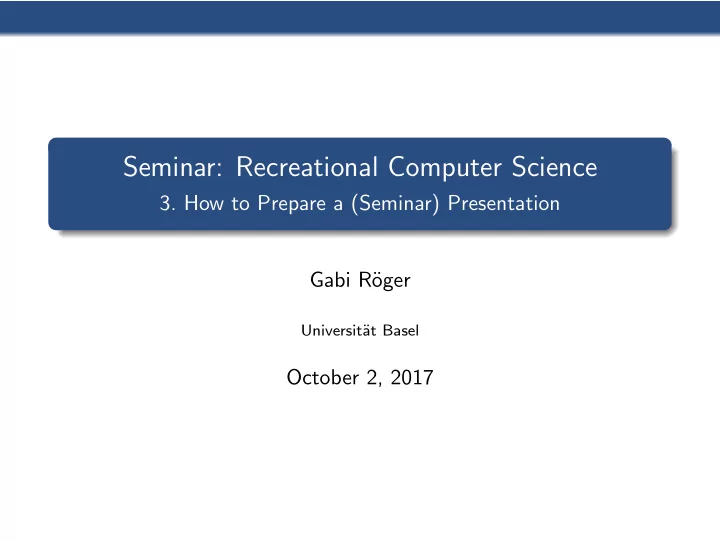

Seminar: Recreational Computer Science 3. How to Prepare a (Seminar) Presentation Gabi R¨ oger Universit¨ at Basel October 2, 2017
Getting Started Structure Slides Presentation Style Most lectures are bad models for seminar presentations.
Getting Started Structure Slides Presentation Style Discuss in groups of 2-3 and take notes: What makes the difference between a good and a bad seminar presentation? (3 minutes)
Getting Started Structure Slides Presentation Style Outline Getting Started 1 Structure 2 Slides 3 Presentation Style 4
Getting Started Structure Slides Presentation Style Getting Started 1 Structure 2 Slides 3 Presentation Style 4
Getting Started Structure Slides Presentation Style Audience You Audience Who is the audience? How large is it? What do they already know? What should they learn?
Getting Started Structure Slides Presentation Style Frame Conditions time and duration size of room presentation equipment other presentations . . .
Getting Started Structure Slides Presentation Style Define the Main Message 35 minutes is short focus on one main message/topic motivate and explain it well
Getting Started Structure Slides Presentation Style Getting Started 1 Structure 2 Slides 3 Presentation Style 4
Getting Started Structure Slides Presentation Style Possible Structure title page introduction outline activation of previous knowledge new information discussion conclusion/summary questions
Getting Started Structure Slides Presentation Style Title Page content title name date/event presentation welcome the audience mention title/topic if not already part of your introduction
Getting Started Structure Slides Presentation Style Introduction get attention of the audience motivating example (positive) provocation presentation of setting . . .
Getting Started Structure Slides Presentation Style Outline structures the presentation for the audience recurring slides with current part highlighted alternative: advance organizer not always necessary Do not give a compact version of your talk!
Getting Started Structure Slides Presentation Style Activation of Previous Knowledge get audience into the topic refresh what they probably already know connections to other presentations interactive component possible but takes time
Getting Started Structure Slides Presentation Style New Information main part of the presentation
Getting Started Structure Slides Presentation Style Discussion experimental evaluation related work relation to previous knowledge
Getting Started Structure Slides Presentation Style Conclusion/Summary take-home message outlook (open questions, advanced topics)
Getting Started Structure Slides Presentation Style Getting Started 1 Structure 2 Slides 3 Presentation Style 4
Getting Started Structure Slides Presentation Style Example: Turing Machines I Definition (Nondeterministic Turing Machine) A nondeterministic Turing machine is given by a 7-tuple M = � Q , Σ , Γ , δ, q 0 , � , E � . Here Q is a finite non-empty set of states , Σ � = ∅ is a finite input alphabet , Γ ⊃ Σ a finite tape alphabet , and δ : ( Q \ E ) × Γ → P ( Q × Γ × { L , R , N } ) is the transition function . State q 0 ∈ Q is the start state , tape symbol � ∈ Γ \ Σ is the blank symbol , and E ⊆ Q is the set of end states .
Getting Started Structure Slides Presentation Style Example: Turing Machines II infinite tape . . . . . . � � � b a c a c a c a � � read-write head
Getting Started Structure Slides Presentation Style Example: Turing Machines III Definition (Nondeterministic Turing Machine) A nondeterministic Turing machine is given by a 7-tuple M = � Q , Σ , Γ , δ, q 0 , � , E � with: Q finite non-empty set of states Σ � = ∅ finite input alphabet Γ ⊃ Σ finite tape alphabet δ : ( Q \ E ) × Γ → P ( Q × Γ × { L , R , N } ) transition function q 0 ∈ Q start state � ∈ Γ \ Σ blank symbol E ⊆ Q end states
Getting Started Structure Slides Presentation Style Pictures and Illustrations “A picture is worth a thousand words.” support of text additional information instead of text lightening the mood
Getting Started Structure Slides Presentation Style Slide Content one statement per slide keywords instead of sentences use examples, pictures, illustrations experimental data: graphs often better than tables formal definitions only if necessary
Getting Started Structure Slides Presentation Style Style default font size or larger colors for highlighting less is more careful usage of animations
Getting Started Structure Slides Presentation Style Getting Started 1 Structure 2 Slides 3 Presentation Style 4
Getting Started Structure Slides Presentation Style Style speak clearly look to the audience (do not talk to the projection) do not read out your slides/notes stay on time
Getting Started Structure Slides Presentation Style Most lectures are bad models for seminar presentations?
Getting Started Structure Slides Presentation Style Questions Questions?
Recommend
More recommend